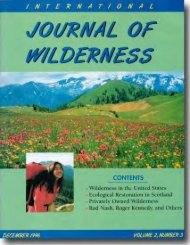Download full PDF - International Journal of Wilderness
Download full PDF - International Journal of Wilderness
Download full PDF - International Journal of Wilderness
You also want an ePaper? Increase the reach of your titles
YUMPU automatically turns print PDFs into web optimized ePapers that Google loves.
Introduction<br />
•<br />
The Bialowieza Primeval Forest (BPF) is an important lowland<br />
forest and a remnant <strong>of</strong> a natural deciduous, temperate<br />
forest ecosystem. The BPF is located on the border<br />
between Poland (58,000 ha. or 143,260 acres) and Belarus<br />
(67,000 ha. or 165,490 acres), 120 miles east <strong>of</strong> Warsaw.<br />
The Belarussian side <strong>of</strong> the BPF has been protected as a<br />
national park since 1991, and the Polish side includes the<br />
•<br />
Bialowieza National Park (BNP) covering only 10,500 hectares<br />
(26,000 acres) (17% <strong>of</strong> the Polish side). Half <strong>of</strong> the<br />
BNP is preserved as a Strict Nature Reserve (SNR) and has<br />
been approved as a Biosphere Reserve and the World Heritage<br />
Site in 1979.<br />
The BPF has been protected in various ways for centuries.<br />
Currently, the most protected area is the SNR, where<br />
use is limited to scientific research and nature-based tourism.<br />
The remainder <strong>of</strong> the BNP is subject to limited intervention<br />
aimed at gradual restoration <strong>of</strong> natural characteristics<br />
and to provide supplemental winter forage to the unique<br />
woodland bison (Bison bonasus) that inhabit the area.<br />
The entire BPF area on the Polish side is national property.<br />
More than 80% <strong>of</strong> that area, including numerous<br />
patches <strong>of</strong> old-growth forest and naturally regenerated<br />
stands, are subject to forest management conducted by the<br />
national forest agency (in Polish: Lasy Pamstwowe [LP]).<br />
Forest management involves harvesting, replanting, and pest<br />
control within the BPF outside the BNP.<br />
At only 525 feet above sea level, the BPF covers a flat area<br />
<strong>of</strong> the watershed between the Baltic and Black Sea hydrological<br />
systems. The influence <strong>of</strong> continental climate causes<br />
a low average annual temperature <strong>of</strong> 43°F, cold winters with<br />
an average January temperature <strong>of</strong> 24.5°F, and an average<br />
annual precipitation <strong>of</strong> only 25 inches. The temperate forest<br />
is mainly represented by deciduous species <strong>of</strong> pedunculate<br />
INTERNATIONAL PERSPECTIVES<br />
Bialowieza<br />
•<br />
Primeval Forest<br />
The Largest Area <strong>of</strong> Natural Deciduous<br />
Lowland Forest in Europe<br />
BY ANDRZEJ BOBIEC<br />
oak, little-leaved lime, Norway<br />
maple, and hornbeam,<br />
but with an abundance <strong>of</strong><br />
Norway spruce—a basic<br />
component <strong>of</strong> boreal forests.<br />
The woodland bison is the<br />
most well-known wildlife <strong>of</strong><br />
the forest area. The focus <strong>of</strong><br />
this article is on the Polish<br />
side <strong>of</strong> the BPF, which is subject<br />
to ongoing forest management<br />
and that could be<br />
protected, like the BNP, as the<br />
largest remaining deciduous<br />
lowland primeval forest in<br />
Europe.<br />
Photo <strong>of</strong> author Andrzej Bobiec. Photo by M. Bobiec.<br />
History <strong>of</strong> the BPF<br />
How could a lowland deciduous forest persist in a natural<br />
state in this region <strong>of</strong> Europe, when it has been under continuous<br />
pressure from various rulers and governments since<br />
the Middle Ages? In the late 1300s, rule in Poland was taken<br />
over by the Great Duke <strong>of</strong> Lithuania, and this began the<br />
coexistence the <strong>of</strong> Kingdom <strong>of</strong> Poland and the Great<br />
Lithuanian Duchy. The duke declared the BPF forest area,<br />
located just on the border between Poland and the<br />
Lithuanian Duchy, as “royal” property and initiated a tradition<br />
<strong>of</strong> royal hunts. One hundred years later, almost 300<br />
hundred rangers were employed in the royal forest area to<br />
keep the public from poaching and woodcutting. The rangers<br />
and their families were awarded continued royal service<br />
(intergenerational) and privileged access to the royal<br />
forest. By the 1620s, two types <strong>of</strong> management zones were<br />
designated in the royal forest: a mainstay area, reserved for<br />
<strong>International</strong> <strong>Journal</strong> <strong>of</strong> <strong>Wilderness</strong> DECEMBER 2002 • VOLUME 8, NUMBER 3 33










